Naples sits on volcanic monsters - and one of them threatens to consume the city

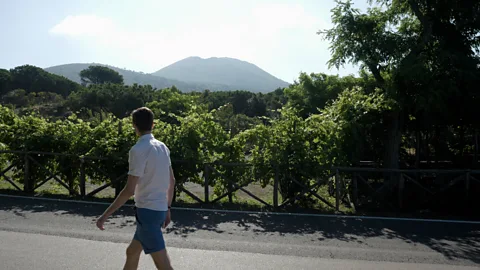 Pomona Pictures
Pomona PicturesBeneath one of Italy's most densely populated cities, there is danger brewing.
Naples is a city that moves at more than one pace. At the fastest speed, you have the chaos of the day-to-day: cars and motorbikes hurtling through the Italian city's streets like blood cells within a vein. Then there is a slower evolution, that of human history. This is a metropolis still shaped by decisions made hundreds of years ago: networks of narrow alleyways that no city-planner would ever design today; modern offices and hotels pressed against Roman ruins and centuries-old villas.
What's less obvious is that Naples also has a geological pace – and it's this one that holds the most power. Mostly it runs at a barely perceptible creep, but every so often, it accelerates into catastrophe: an eruption of fire and rock that disrupts all other timescales in the city.
The volcanoes of Naples keep a different time to human beings – evolving over decades, centuries or even millennia – so it can be easy to assume they are static. This is far from the truth.
Vesuvius is the best-known, most famous for destroying Pompeii and Herculaneum in 79AD. It towers above the city. But there are other subterranean threats here, and some of them have far more bottled force. In fact, one of these colossal volcanoes is showing worrying signs that it is about to erupt – and there are hundreds of thousands of people living right on top of it.
To find out what it's like to live and work alongside these monsters, I recently visited Naples to make a film for the BBC, speaking to the geologists who study and watch them 24-hours a day. I discovered a city creeping towards disaster, but no-one can say for sure when or where it will happen.
One of the last times Naples experienced a major volcanic event was exactly 80 years ago this week. In mid-March 1944, during World War Two, caches of magma and gas that had been slowly building beneath Vesuvius suddenly began to erupt.
A US military doctor, Leander Powers, who was stationed in Italy at the time, described what he saw: "While we were just finishing supper, someone called to say there were huge red streams of lava flowing down the sides of Mount Vesuvius…we could see a glow in the sky. All during the night and Sunday there were quakes of the earth with tremendous roars – similar to thunder... The windows rattled, and the entire building vibrated."
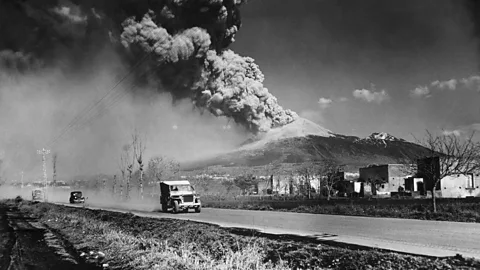 Getty Images
Getty ImagesThe following day, events escalated: "The roars became more frequent and grumbled like a lion's roar," Powers wrote. "Streams of fire were shooting thousands of feet into the air, and the countryside was lit up for miles around. Oft times the entire top of the mountain looked as if it were a blazing inferno."
Naples shakes
On 20 May 2024, homes were evacuated and schools closed after a flurry of 160 earthquakes in the Naples region. One was recorded at a magnitude of 4.4 near the town of Pozzuoli, which sits on Campi Flegrei. It was the strongest in the region for 40 years.
The earthquakes are due to an increase in seismic activity caused by gases or magma below – but it remains unknown whether it signals a potential eruption.
A news report from the time shows astonishing footage of the giant ash cloud, turbulent lava flows, and collapsing buildings. More than 20 people died.
Today, Vesuvius is far quieter, and that catastrophic event in 1944 is beginning to fade from collective memory as older generations pass away. Nowadays, the summit is a tourist attraction with coaches ferrying people to the top, and souvenir stalls selling fridge magnets made from solidified lava. I came to follow a group of artists and scientists who were climbing to the summit of Vesuvius on a field trip, as part of a festival called Volcanic Attitude.
Vesuvius is not like a normal mountain. Usually when you reach a summit, you look out to the surrounding view, but here, the eye is drawn inwards, to a giant crater. When the writer Joseph Addison came here in the 1700s, he called it a "dreadful vault".
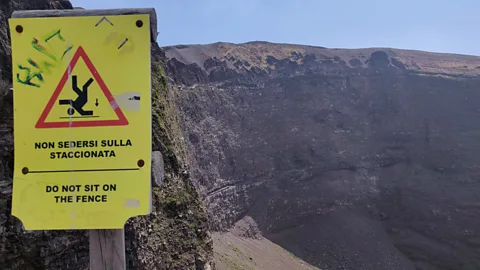 Richard Fisher
Richard FisherWhen I peered over the fence, however, I saw only shattered rock and a few clouds of sulphurous smoke. It was a sublime experience to encounter an entity with the magnitude and power to destroy me, but fortunately there was no sign of its past fury.
Nonetheless, Vesuvius remains active, and one day, it will blow again. On the way up, the geologist Giovanni Macedonio of the National Institute of Geophysics and Volcanology (INGV), who was guiding our party, pointed out the ruined topography of past eruptions. When Vesuvius goes off, he explained, it won't be a trickle. In the past, entire hillsides have been blown to pieces. Beneath Naples, the African tectonic plate is colliding and descending beneath Europe, creating a more combustible mixture of magma and gas than volcanoes in places like Iceland or Hawaii.
"Here we have very violent eruptions," Macedonio explained in a talk at the summit. "In terms of energy we're talking about several nuclear bombs. With the difference that with nuclear explosions, the energy is released in less than a millisecond, here that energy is released over several days. But when we calculate the energy in these events, we're looking at tens, hundreds or even thousands of Hiroshimas."
Anticipating that threat, Naples officials have organised the city into zones: those in the "red zone" must evacuate if the threat level rises high enough. Each of these neighbourhoods is twinned with a canton elsewhere in Italy, which will take in people fleeing disaster.
Navigating Naples' chaotic traffic and jammed streets, it's difficult to imagine how that might happen in practice. One geologist I spoke to during my trip suggested that, if a warning came, it might well be quicker to walk to safety than try to drive.
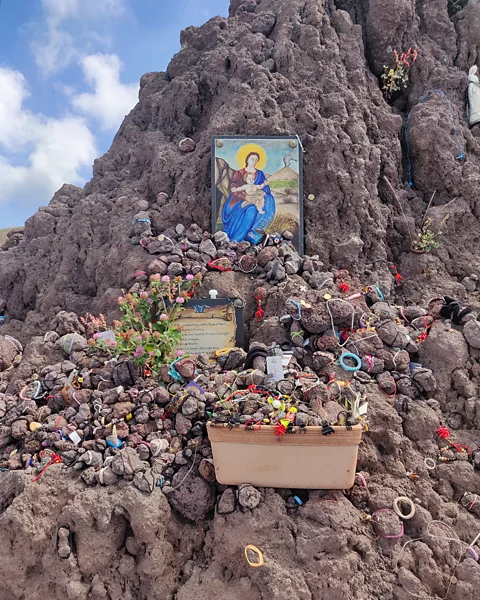 Richard Fisher
Richard FisherLater that day, I visited the observatory where geologists keep tabs on Vesuvius and the other volcanoes of Campania, 24-hours a day. Once housed on the slopes of Vesuvius itself, the monitoring station now operates from a nondescript office block not far from the city centre. Inside, though, it looks like a space mission control room, with multiple screens across two walls, showing seismological graphs, maps and cameras focused on venting gases far away.
It was here I saw hints of a far bigger volcanic threat than Vesuvius, which geologists are currently keeping a close eye on. Outside the building, you might not know it's there, but here on a giant screen you can see evidence of its presence: a map of the city covered with swarms of coloured dots. They are tremors caused by magma and gases shifting deep underground, and in recent years they have been felt frequently across Naples. On 20 May 2024, the area was shaken by 160 earthquakes, including one with a magnitude of 4.4, the strongest to hit the region in 40 years.
The cause? Beneath the city – and indeed most of the bay – there's an enormous "caldera", a type of volcanic crater that collapsed after a violent eruption thousands of years ago. It's called the Campi Flegrei (Phlegraean Fields), and it is 12-15km wide (7.5-9.5 miles). Unlike Vesuvius, it has no visible cone, and so goes largely unnoticed day-to-day, but with so many people living on top of it, it's considered one of the most dangerous in Europe. One eruption attributed to it 39,000 years ago was so big that some of the material ended up in Siberia.
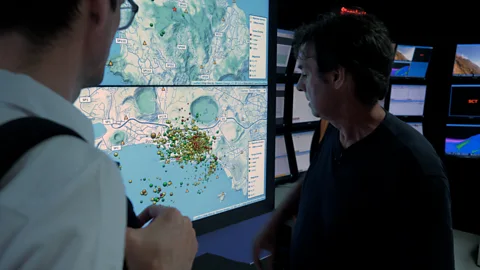 Pomona Pictures
Pomona PicturesWhile making our film, I toured this monster with the geologist Vincenzo Morra of the University of Naples Federico II, who lives and works on the volcano, within Naples' red zone. He picked me up from the train station on his scooter, and as we zipped in between busy traffic, I realised that he probably has a higher appetite for risk than me.
"People aren't really aware that we're walking on a volcano on a daily basis, that we're inside a volcano," he told me. A third of the caldera is submerged underwater but the remaining two-thirds are under people's homes and businesses.
It's difficult to see the full extent of Campi Flegrei – it's too big to take in unless you're flying above the bay. But we stopped off at one part of it: a place called the Solfatara, where Morra showed me a white, steaming sulphurous landscape, like the surface of an alien world. It used to be open to tourists intrigued by its hydrothermal sights and smells, he explained, but a few years ago it was closed when three members of a family fell into a crater there and asphyxiated.
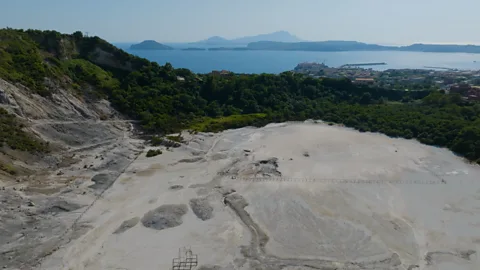 Pomona Pictures
Pomona PicturesMany people assume that the Solfatara is the volcano, but it's actually only one portion. Various other sites in the area are also part of Campi Flegrei, from the hill Monte Nuovo where there was an eruption in the 1500s, to the Grotta del Cane (Cave of Dogs), which used to be a macabre tourist attraction due to the dense volcanic CO2 collecting on its floor. In the 1800s, people would lead dogs into the cave where they'd drop unconscious due to the fumes (if standing, human visitors were unaffected).
This widespread distribution of volcanic effusions, however, means that it's unclear where any future activity might take place. "The eruptions migrate over time, so we'll never know where, nor when of course, there'll be the next eruption," says Morra. "And that of course makes the Campi Flegrei more dangerous than Vesuvius."
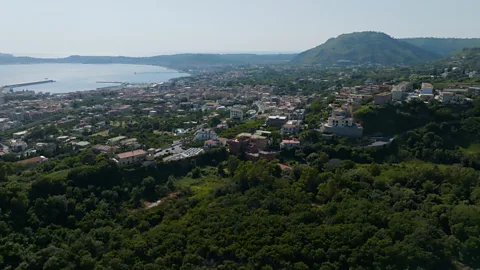 Pomona Pictures
Pomona PicturesOne evening, I had dinner in the port town of Pozzuoli, a Naples suburb near the centre of the Campi Flegrei caldera, with Christopher Kilburn, a volcanologist at University College London in the UK. He is not a resident, but through spending time here, he has developed a strong affinity to the city and its residents. As children played and people ate al fresco in the July sun, we discussed the chilling prospect of a looming eruption.
At the time, Kilburn and his colleagues had just published a paper about Campi Flegrei that is uncomfortable to read. Using a new model of the caldera, it suggests that an eruption could happen in the foreseeable future. Lately, the volcano has been rumbling and expanding in a way that has Kilburn and other geologists debating the causes.
Over the centuries, magmatic and gaseous changes deep within Campi Flegrei have caused Pozzuoli and the surrounding area to continually rise and fall. That's the reason the Roman settlement of Baiae is now submerged in the bay.
Yet in recent decades, the ground beneath Pozzuoli has been doing some unusual things. Between 1969-1972 and 1982-1984, it uplifted in rapid bursts. Altogether since the 50s, the uplift adds up to more than 4m (13ft). You can see the consequences at the town's water-line: officials have had to install a second set of moorings in the harbour after the first row rose out of reach of the boats.
"The question is, were these caused by pulses of magma or gas? We don't know," says Kilburn. Fortunately, no eruptions followed – and if it was magma, it would have solidified by now.
However, what is clear is that the caldera has started to act differently over the past decade or so: there's been a period of sustained subsidence followed by much slower uplift.
Kilburn and colleagues interpret this to mean that the volcano is doing something new. If the previous uplifts were benign magmatic intrusions, then this would suggest the recent changes could be gas, he says. And if so, that could mean the volcano is essentially inflating, creating new gaps for magma to push through – and potentially reach the surface. "The crust today is not in the state it was 40-50 years ago," he says. "Whether there's an imminent eruption or not, it's unusual that a volcano does this."
Kilburn acknowledges that other researchers have different interpretations, and the authorities are not ready to raise the threat level yet. Predicting volcanoes in Naples can be a political – and controversial – affair. After all, claiming an eruption might be imminent creates fear in the public, and calling an evacuation can have severe economic consequences. Not to mention raising a "cry wolf" problem if it turns out wrong.
More like this:
The official line from the operators of the Vesuvius observatory is that an eruption is not imminent. Some Italian geologists speaking in a private capacity go further, claiming there's no reason to worry. Others, like Kilburn, say prudence and preparation is advisable given the recent changes in the data.
"The fundamental problem we have is that we can't see what is happening down there," says Kilburn. Despite decades of close study, there is still no technology capable of peering with enough clarity into the bowels of volcanoes like Campi Flegrei. A drilling project was once proposed, but it was shelved after some raised fears of triggering an eruption.
When it comes, it's possible that Campi Flegrei will give the citizens of Naples a warning. We only have one eruption in historic records to go on – in 1538 – and that did show itself before it blew. "Supposedly, there was an uplift of several metres within 48 hours. There's always the hope that we'll get that sort of warning again," says Kilburn.
However, Campi Flegrei, Vesuvius and all the other volcanoes in this region are evolving on a timescale all of their own. When they accelerate into catastrophe, it could be tomorrow – it could be decades or perhaps even centuries – but one thing is far more certain: the creep towards that day is inevitable.
*Richard Fisher is a senior journalist for BBC.com and the author of The Long View: Why We Need to Transform How the World Sees Time. Twitter: @rifish
Filming and production by Pierangelo Pirak and colleagues at Pomona Pictures.
--
This article was originally published on 22 March 2024. It was updated on 21 May 2024 to include details of the recent seismic activity and earthquakes in the area around Naples.
--
If you liked this story, sign up for The Essential List newsletter – a handpicked selection of features, videos and can't-miss news delivered to your inbox every Friday.
